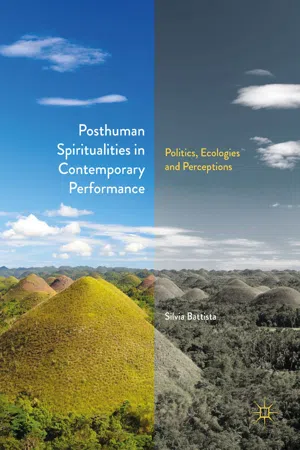Susan Sontag , in the book Styles of Radical Will, calls for a revision of ‘the project of “spirituality ”’ for our era, encouraging intellectual engagement with the reinterpretation of this term through contemporary lenses, new thinking and innovative practices (Sontag 2002, 5). This book engages with this challenge and proposes an interpretation of spirituality through performance and the theoretical lenses of performance studies , post-human theories, religious studies, radical hermeneutics and phenomenology. It proposes performance as an inclusive lens of interpretation able to blur the boundaries culturally set for artistic, religious and scientific planes of existence, to ground the ‘project of “spirituality ’’’ in materiality , experimentation , creativity , imagination and the paradoxical.
This is an operation aimed at opening the concept of
religion to
the ‘study [of] the wide range of experiences to which religious significance has been attributed’ (Taves
2009, 8);
in other words, to what is deemed to be religious within the non-religious rather than what is religious because it has been institutionalised as such. As the religious studies scholar
Ann Taves argues:
we need to turn our attention to the processes whereby people sometimes ascribe the special characteristics to things that we (scholars) associate with terms such as “religious”, “magical”, “mystical ”, “spiritual”, etcetera. (ibid.)
Hence, by inverting the paradigm , it is conceivable to explore ‘the interaction between psychobiological, social, and cultural-linguistic processes in relation to carefully specified types of experiences’ (ibid.), and consider what else within the spectrum of human behaviour can reveal insights into what we understand as spiritual, religious, mystical , numinous , sacred and so on.
I consider theatre and performance to be significant in this regard, as there is a history of artistic experimentation with those areas of practical investigation. This is certainly a vast territory that might include, to mention only a few: the theatre of cruelty as envisaged by Antonin Artaud ; the psychomagic rituals conceived by Alejandro Jodorowsky; Michael Harner’s core-shamanism ; the Panic Theatre of Fernando Arrabal, Alejandro Jodorowsky and Roland Topor; Jerzy Grotowski’s para-theatre ; Richard Schechner ’s environmental theatre ; the ritualistic practices of Anna Halprin; performance artists such as Marina Abramović , Joseph Beuys, Marcus Coates , John Cage , Linda Montano, Tehching Hsieh , and visual artists such as James Turrell , Wolfgang Laib as well as many others.
Within this broad landscape, I propose to look at performances/ installations inspired and devised specifically around spiritual practices with their origins in religious traditions. So, for example, Chapter 1 focuses on the performance The Artist is Present (2010) by Marina Abramović , devised around the mystical practice of reciprocal gazing ; Chapter 2 looks at the performance CAT by Ansuman Biswas (1998), devised around the practice of Vipassana meditation of the Theravada Buddhist tradition ; Chapter 3 focuses on the installation piece Deer Shelter Skyspace (2007) by James Turrell , that recalls the architecture of the Quakers’ prayer room ; Chapter 4 explores the performance Journey to the Lower World (2004) by Marcus Coates , devised around shamanic journey practices; and finally, Chapter 5 analyses the pieces Pollen from Hazelnut (1986) by Wolfgang Laib , who has been inspired by Asian religions such as Buddhism , Jainism and Hinduism , and has developed a practice for collecting and presenting pollen in gallery spaces . 1
These artistic interventions are representative of a loose category of practices that I associate with what Susan Sontag , in the essay ‘The Aesthetics of Silence ’, identifies as the via negativa in art or a negative ‘theology’ of art ’s absence in art (2002, 5). They resonate with religious and mystical literature, but also paradoxically with science and its experimental paradigms. This is due to the artists ’ engagement with the creative process not as a means of self-expression , but rather, and to different extents, as a means of self-restraint and experimentation with levels of consciousness often associated with spiritual experiences . Art is therefore viewed as ‘a vehicle ’ 2 for involving spectators /participants in levels of experiences that touch on that liminal space between discovery, experience , creativity and imagination , revealing the performance of those invisible, intangible human and non-human ‘others’ which are usually excluded from our perceptive fields . These ‘others’ emerge and enter the perceptive horizon due to a change of practices that by irrupting and disrupting perception , reveal the paradoxical numinosity of reality , leaving spectators and researchers alike puzzled and disconcerted.
This is an artistic attitude that looks at ‘sketching out new prescriptions for looking [and] hearing’; at delivering ‘a more sensuous experience of art ’; and, more generally, at offering modalities for focusing attention on overlooked aspects of reality (Sontag 2002, VI).
Performance and Spirituality
Although there is an increasing body of scholarly work engaging with the question of spirituality and religion in contemporary art , these terms, as the historian Tomoko Masuzawa points out, are still largely treated within these disciplines as self-evident categories, remaining peculiarly ‘essentialized, un-historicized and un-analyzed’ (Bordowitz et al. 2009, 124). 3
As Lance Gharavi explains in his introduction to the book Religion , Theatre , and Performance : Acts of Faith (2012), in performance and theatre studies , the question of religion remains an uncomfortable subject of inquiry (2012, 7). Although historically there is an intimate relationship between performance and religion , the same relationship has also been characterized ‘by long stretches of hostility and mutual suspicion’ (ibid.). In performance , theatre and cultural studies , although religions as we know them are cultural constructs that came into being at a certain time and under certain social and political conditions, the study of what constitutes ‘the religious’ and ‘the spiritual’ in contemporary culture remains a sui generis subject of inquiry (Gharavi 2012, 15). Therefore, in broad terms, this book proposes to contribute to the project of studying the ‘religious’ within the ‘spiritu...
